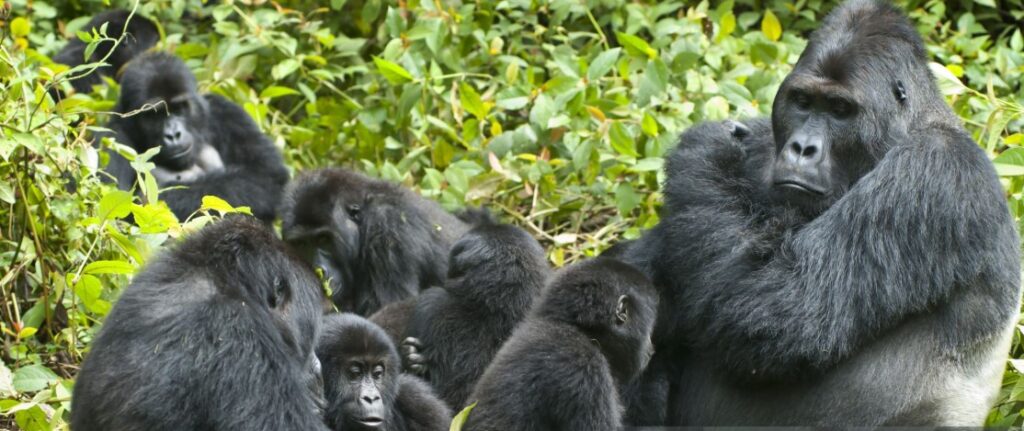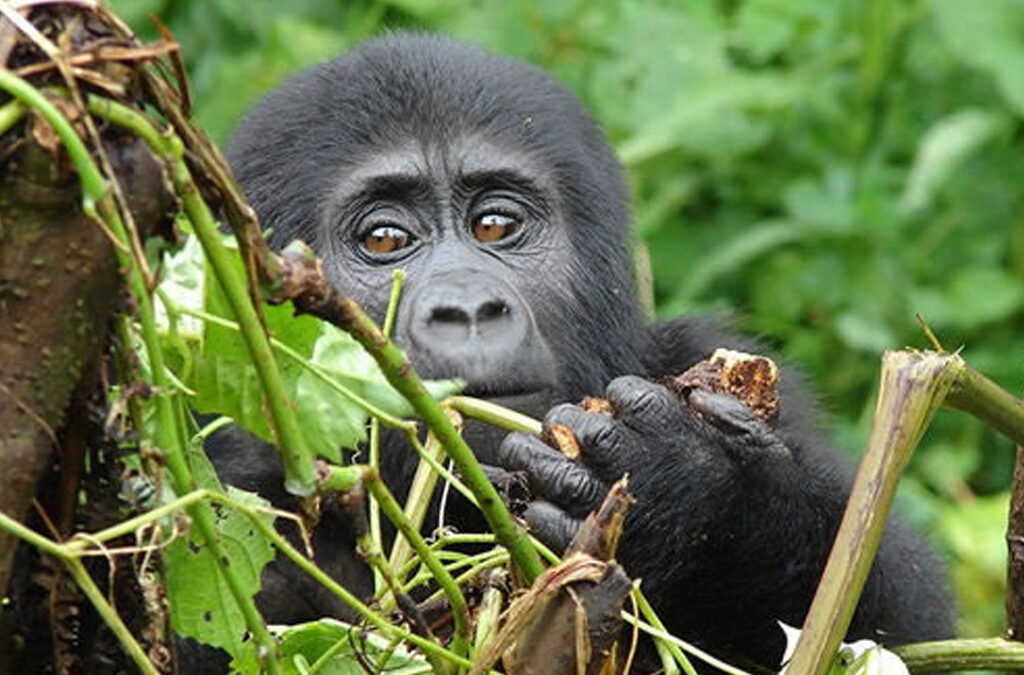- GET IN TOUCH WITH US:
- +256 753518160
- +256 777842166
- info@experiyatourcompany.com

Big Five Safari Experience in Murchison Falls National Park
July 25, 2025
Why Uganda is the Best for First-Time Travelers
July 26, 2025Gorilla Trekking vs Traditional Safari: East Africa’s Ultimate Wildlife Experiences
East Africa stands as one of the world’s premier wildlife destinations, offering two distinctly different yet equally captivating adventures: gorilla trekking in the misty mountains of Uganda and Rwanda, and traditional safari experiences across the legendary landscapes of Kenya, Tanzania, and northern Uganda. Each journey provides a unique window into Africa’s natural heritage, but they cater to vastly different travel styles, expectations, and desires.

The decision between these two experiences often comes down to understanding what drives your wanderlust. Are you seeking the profound intimacy of sitting quietly in a mountain forest while a family of gorillas goes about their daily routine just meters away? Or does your heart race at the thought of witnessing the thunderous spectacle of two million wildebeest crossing the Mara River during the Great Migration?
The Mountain Forest Experience: Gorilla Trekking in East Africa
Gorilla trekking in East Africa takes place in two primary locations: Uganda’s Bwindi Impenetrable National Park and Rwanda’s Volcanoes National Park. These ancient forests, shrouded in mist and mystery, harbor one of humanity’s closest relatives in the animal kingdom. The experience begins long before your first gorilla encounter, starting with the journey into landscapes that seem untouched by time.
Bwindi Impenetrable National Park
Uganda’s Bwindi Impenetrable National Park lives up to its name. This 321-square-kilometer UNESCO World Heritage Site protects one of Africa’s oldest forests, estimated to be over 25,000 years old. Its terrain is a challenging tapestry of steep ridges, deep valleys, and dense vegetation that creates a cathedral-like atmosphere. Home to approximately half of the world’s remaining mountain gorillas, Bwindi offers multiple trekking sectors, each with access to different habituated gorilla families.
Volcanoes National Park
Rwanda’s Volcanoes National Park offers a different but equally compelling setting. Located in the Virunga Mountains, the park encompasses the Rwandan portion of the Virunga Massif, where Dian Fossey conducted her groundbreaking gorilla research. The landscape is dominated by volcanic peaks, bamboo forests, and open meadows, providing dramatic backdrops for gorilla encounters. The park’s higher altitude and more open terrain often make trekking conditions slightly easier compared to Bwindi’s dense undergrowth.
Gorilla Families and the Trekking Experience
The gorilla trekking experience is intensely personal and deliberately intimate. Groups are limited to eight people, creating an atmosphere more akin to a private wildlife encounter than a typical tourist activity. Each morning begins with a ranger briefing on safety protocols and information about the specific gorilla family you’ll track. Every family has unique personalities, dynamics, and territorial preferences, ensuring each trek is one of a kind.
Tracking gorillas can take anywhere from 30 minutes to six hours, depending on their movements. Experienced trackers communicate via radio to guide trekking teams to the gorillas’ current location. When the moment finally arrives, the rustling of leaves gives way to face-to-face encounters with beings that share 98% of our DNA.
The Hour That Changes Everything
The hour spent with the gorillas passes with startling speed. Watching juvenile gorillas play, mothers groom their infants, and silverbacks oversee their families offers insight into emotional intelligence and social complexity strikingly similar to our own. Every gesture feels significant, every moment deeply moving.
Photography During Gorilla Encounters
Photography is both rewarding and challenging. Flash is prohibited, and the forest’s filtered light demands quick reflexes and high ISO settings. Many photographers wrestle with the choice between capturing the moment and simply living it. For many, the most powerful memories are etched not on memory cards, but in their hearts.
Physical Demands
Gorilla trekking is physically demanding. Trails rise between 2,300 and 4,300 meters above sea level. Trekkers face steep inclines, slippery mud, dense vegetation, and unpredictable weather. Preparation is key: waterproof gear, sturdy hiking boots, and mountain hiking conditioning are essential
The Savanna Spectacle: Traditional Safari in East Africa
Traditional safaris unfold across some of the world’s most iconic landscapes: the endless plains of Tanzania’s Serengeti, Kenya’s legendary Masai Mara, the Ngorongoro Crater, and the elephant-rich lands of Amboseli. Here, specially modified vehicles become mobile observation platforms in nature’s grandest theater.
Serengeti National Park
The Serengeti ecosystem spans over 30,000 square kilometers across Tanzania and Kenya. It offers dramatic safari experiences, especially during the Great Migration. Over two million wildebeest, zebras, and gazelles follow ancient routes shaped by rainfall. Witnessing river crossings, where crocodiles and lions lie in wait, ranks among the most breathtaking wildlife events on Earth.
Masai Mara
Kenya’s Masai Mara, the Serengeti’s northern extension, hosts migration herds between July and October. The Mara’s rolling grasslands and acacia woodlands offer top-tier wildlife viewing year-round. Predator-prey interactions reach their peak during migration, but the park’s resident wildlife ensures exceptional encounters throughout the year.
Ngorongoro Crater
The Ngorongoro Crater is a natural amphitheater teeming with life. This ancient volcanic caldera supports one of Africa’s densest predator populations. Its self-contained ecosystem offers unparalleled game viewing, with grasslands, lakes, and forests that attract wildlife year-round.
Amboseli National Park
Amboseli is renowned for its elephant herds and views of Mount Kilimanjaro. Its semi-arid landscapes are dotted with swamps that draw animals seeking water. Researchers here have tracked individual elephants for decades, giving guides intimate insights into family hierarchies and personalities.
Game Drives and Wildlife Variety
Game drives typically occur in the early morning and late afternoon, aligning with animal activity. From lions hunting in golden light to elephants drinking at waterholes, each outing is unpredictable and exciting. A single drive might include encounters with lions, elephants, leopards, cheetahs, hyenas, and rare species like wild dogs or rhinos.
Photography and Comfort
Safari photography benefits from open landscapes and stable platforms. Long lenses capture intimate animal portraits, while sweeping vistas frame dramatic compositions. Depending on your preference, you can choose from luxury lodges, mid-range tented camps, or basic camping setups each offering different levels of immersion and comfort.
Comparing the Wildlife Encounters
The key difference between gorilla trekking and traditional safaris lies in depth versus breadth. Gorilla trekking offers deep, focused interaction with a single species, often described as transformative. Traditional safaris offer variety dozens of species across diverse ecosystems with constantly changing sights and stories.
While gorilla trekking guarantees a close-up encounter once the gorillas are found, safari sightings depend more on timing, weather, and luck. Gorilla behavior offers mirrors of our own: emotional expressions, learning, discipline, and social play. Safari behavior highlights ecosystem-wide dramas: hunts, migrations, and the daily struggle for survival.
Physical Demands and Accessibility
Gorilla trekking is physically intense, suitable for fit individuals aged 15 and above. The terrain is steep, slippery, and muddy, with weather changing rapidly. Trekking requires stamina, agility, and preparation.
Traditional safaris are accessible to almost everyone. Game drives require minimal walking and are ideal for older travelers, young families, or people with mobility challenges. Safari vehicles provide comfort, protection, and excellent visibility in all weather.
Cultural and Community Connections
Both experiences offer meaningful cultural exchanges. Gorilla trekking regions in Uganda and Rwanda emphasize community-based tourism. Many locals are former poachers turned conservationists, guiding treks and sharing ancestral forest knowledge.
Traditional safari destinations also incorporate community visits, particularly to Maasai communities in Kenya and Tanzania. These experiences range from dance performances to immersive visits exploring pastoral life and conservation values.
Seasonal Considerations and Planning
Gorilla Trekking Seasons
Gorilla trekking is possible year-round. Dry seasons June to September and December to February offer better trail conditions, though they are also peak travel periods. Wet seasons offer lush scenery and fewer tourists but come with challenging trails and higher rainfall.
Safari Seasons
The dry season is prime time for safaris. Wildlife concentrates near water sources, vegetation thins out, and viewing conditions improve. Migration patterns add complexity: from January calving in the Serengeti’s south to dramatic Mara River crossings in July and August.
Wet seasons bring lush greenery, fewer tourists, baby animals, and vibrant birdlife, but they can also mean dispersed wildlife and harder-to-navigate roads.
Making Your Decision: What Matters Most?
Choose Gorilla Trekking If You:
Seek profound, emotional connections with wildlife
Enjoy adventure and physical challenges
Are curious about primate behavior and human-animal kinship
Prefer shorter, high-impact trips
Choose Safari If You:
Want to see a wide range of species and landscapes
Prefer vehicle-based exploration with comfort
Enjoy photography across different subjects and light conditions
Travel with groups of varying fitness levels
The Best of Both Worlds: Combine Gorilla Trekking and Safari
Many travelers find that combining both experiences provides the ultimate East African adventure. A 2–3 day gorilla trek followed by a 5–7 day safari creates a perfectly balanced itinerary. Regional flights and well-developed tourism infrastructure make combinations seamless.
This contrast between the spiritual intensity of the forest and the grandeur of the savanna enriches every aspect of the journey. It’s a full-circle experience of East Africa’s remarkable diversity, from the eye-to-eye intimacy with gorillas to the sweeping drama of lion hunts and wildebeest migrations.
Embrace the Wild Heart of East Africa
Gorilla trekking and traditional safari are not competing adventures they are complementary chapters in East Africa’s story. Whether you are moved by the soulful gaze of a silverback or thrilled by the charge of a bull elephant, these experiences will change the way you see natureand yourself.

